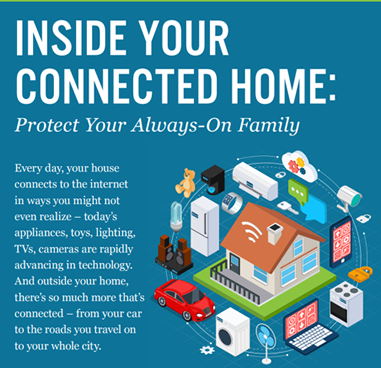Americans use 3,138,420 GB of internet data every minute of the day.
It is safe to say that being online is now a way of life for many. Engaging in safe and secure online practices helps protect against the risks of living life on the internet.
Shopping, surfing, banking, gaming, and connecting Internet of Things devices such as toasters and refrigerators are some of the many actions performed each minute in cyberspace. These common everyday activities carry the cyber threats of social engineering to gain unauthorized access to data, identity theft, bullying, location tracking, and phishing, to name just a few. How can we decrease our risk from these cyber threats without abandoning our online activities altogether? Here are some basic online tips everyone can follow to help stay secure while online.
- Set up alerts. Consider setting up alerts on your financial accounts. Many credit card companies and banks allow you to set up alerts on your accounts via their websites. These alerts range from sending you an email or text each time a transaction happens on your account to alerts when transactions meet or exceed a designated spending limit that you set. These alerts keep you in control of your accounts’ activities. These types of alerts are useful because they make you aware of what’s going on with your account quicker than waiting for monthly statements. When you receive an alert about a transaction that you did not authorize, you can reach out to the credit card company or bank immediately. Log into your credit card company and banking websites to set up alerts on your accounts.
- Keep devices and apps up to date. This familiar tip is useful even if you are just casually surfing the internet. Keeping your devices up to date (including apps and operating systems) ensures you have the latest security fixes.
- Don’t use public Wi-Fi. In addition to an updated device, the network the device is connected to is also important. Did you have to enter a password to connect to a Wi-Fi network? If you did, that network is more secure than an open one that any device within range can connect to. Whenever possible, use a secure network, especially when banking or shopping online.
- Consider using a VPN. VPN stands for virtual private network, and its main purpose is to provide a tunnel for encrypted internet traffic. If you are connected to the internet without using a VPN, your traffic is passed through the internet service provider’s servers. The location of your device is known, and if you must connect to a public Wi-Fi network, there is a risk of snooping by other devices on the same network. Connecting to a VPN redirects your internet traffic to a remote server, encrypting the traffic, reducing the snooping risk. There are many options for VPN software today for consumers and businesses. Do your research and decide which one makes sense for your online needs.
- Create unique passwords. Here’s another familiar tip. Using the same password for many sites is not a best practice. Suppose that one of your accounts suffered a data breach and your password was exposed. If you reused this password on other accounts, it’s likely that someone would be able to access those accounts as well (especially if your user name is an email address). Consider using a password manager to manage all your passwords. Not only do these tools manage all your passwords, they can also create strong passwords and can even autofill your username and password as you go to websites on different browsers.
- Be vigilant. Be aware, there are fake websites out there waiting to collect your valuable information. Make sure you are on a legitimate site by double-checking the URL website address to make sure it is spelled correctly. Also make sure you see a padlock and https:// in the URL.
Remember that you are in control of your online activities. Following these security tips will give you peace of mind while online.
Additional resources
- Download the US Department of Homeland Security Social Media Guide.
- Learn about Password Managers.
- STOP. THINK. CONNECT.: The Basic Steps to Online Safety and Security
- STOP. THINK. CONNECT.: Tips for Passwords & Securing Your Accounts
- Are You Sharing Too Much Information Online? (video)
- Considering Posting That Cute Vacation Selfie? (video)
Campus Security Awareness Campaign 2019
This post is part of a larger campaign designed to support security professionals and IT communicators as they develop or enhance their security awareness plans. The campaign is brought to you by the Awareness and Training Working Group of the EDUCAUSE Higher Education Information Security Council (HEISC).
